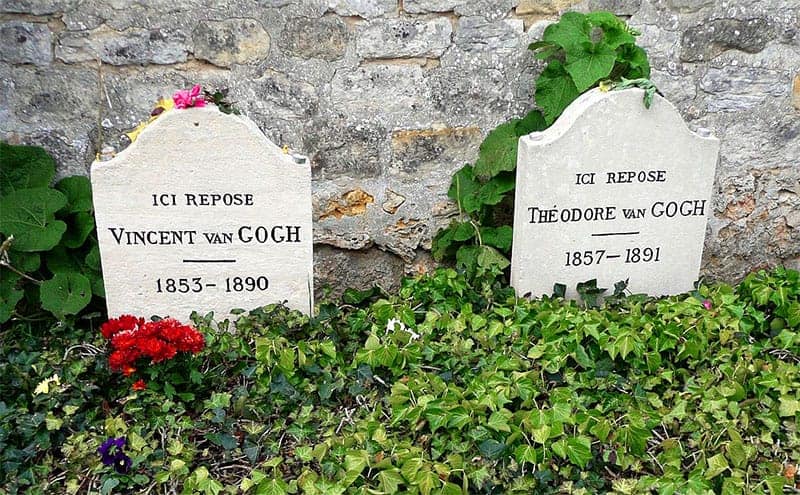Last Updated on December 15, 2023

Estimated reading time: 4 minutes
by Donna Manz
Several months ago I took an excursion to Auvers-sur-Oise, France, a country town north of Paris that pays homage to its most famous resident, post-Impressionist master Vincent van Gogh.
During the two and a half months an anguished Vincent van Gogh lived in Auvers-sur-Oise, the artist painted more than 70 works of art and gave many of them to Dr. Paul Gachet, his doctor and friend. Today many of those pieces hang in the Musée d’Orsay in Paris, and connecting van Gogh’s life in Auvers-sur-Oise to the museum pieces piqued my curious nature.
While Van Gogh’s time in Auvers-sur-Oise was brief, the artist-town became famous as the place where he died. While most van Gogh historians believe he killed himself (although it’s still being debated) how he died does not haunt me as much as how he lived.
Van Gogh’s stayed at the Auberge Ravoux, a small inn that was a favorite among artists, and his sparsely furnished room number 5, is open to the public. Down below, the inn’s restaurant Ravoux, where the master took many of his meals, remains in operation today.
Looking into van Gogh’s drab, colorless bedroom with an empty bed as its focus, I felt sadness and pity for the man. As masterful as he was at translating his view of the world into art, he could not overcome the torment that marked his works. Being there I was reminded of the Don McLean song, “Vincent,” an ode to van Gogh.
Auvers-sur-Oise is still a quaint town, walk-able and history-laden. From behind the Auberge Ravoux, I followed the paths that van Gogh did, inhaling the stillness, noting the almost-eeriness. As I walked about the village I looked up at the Eglise d’Auvers, the church he and other post-Impressionists painted, and passed by the wheat fields he immortalized. I could almost “see” van Gogh and artist Camille Pissarro painting the life of the village, and wished then that I knew more about van Gogh the artist and the person.
It’s hard to find levity in Auvers-sur-Oise but an animal brought life and silliness to my day there. While climbing the steep path that winds its way up to the Cimetière d’Auvers where van Gogh is buried next to his brother, a deep hideous bellow pierced the air. I had been lagging behind my tour group, and I stopped to attempt to locate the source of the unrecognizable sound.
It repeated itself, and, as I turned toward its direction, I found myself looking upward to a grassy hill abutting the path. There, staring back down at me was a donkey demanding attention. “It’s a donkey,” I called out to my fellow tourists. They walked back down, cameras in-hand, and the animal continued to bray, posing, until the paparazzi facing him snapped his photo. Satisfied with his recognition, he quieted down, and watched us as we continued on. It made me think of the juxtaposition of this theatrical donkey and the reverence Auvers holds for van Gogh.
Visiting the van Gogh collection at Musee d’Orsay, I sought out the names of the benefactors who had contributed van Gogh’s art. I found that most had been contributed by Marguerite Gachet, daughter of Dr. Gachet.
Standing before the masterpieces I thought of how I had stood in those places in Auvers-sur-Oise where they had been created. I had formed a connection to history and I left feeling I understood a bit more about van Gogh and his vision of his world.
If You Go to Auvers-sur-Oise:
In late spring and early summer, Auvers-sur-Oise looks much as van Gogh saw it. Spring and early summer are the most pleasant seasons to walk about the compact town that is less than 20 miles from Paris. By train, the trip takes about an hour.
If you depart from Paris’s Gare du Nord or Gare Saint Lazare, take a train to Pontoise, changing there for a train in the direction of Persan-Beaumont. Get off at Auvers; the Ravoux Inn is a 10-minute walk from the station.
You may also want to consider a day trip from Paris by scheduled tour operators. Day excursions include transportation, admission to van Gogh’s rooms and a guided tour of the town. Your hotel can book these on your behalf.
The Ravoux Inn, right in the middle of Auvers-sur-Oise in the Place de la Mairie, continues to operate as a restaurant. Entrance fee to room number 5, van Gogh’s, is 5 Euro. Dr. Gachet’s home, at (surprise!) 78 rue du Docteur Gachet is also open to the public for a small fee.
On your way to the cemetery, look for the braying donkey behind the Ravoux inn. He’ll pose for you.

Leave a Reply